Economics for Business: UK Food Industry Analysis and Market Failure
VerifiedAdded on 2022/12/26
|16
|3315
|92
Report
AI Summary
This report provides an economic analysis of the UK food industry, focusing on the impact of Brexit and COVID-19. It examines supply and demand dynamics, market equilibrium, and the factors leading to market failure. The report explores how these events disrupted supply chains, altered consumer behavior, and led to business failures within the food industry. It also discusses government policies implemented to address market failures and restore equilibrium. The analysis covers the interaction of supply and demand, shifts in the supply and demand curves, and the resulting shortages and surpluses in the market. The report highlights the challenges faced by the food industry and the government's role in maintaining social welfare and market stability. The study uses economic principles to explain the complex interplay of factors affecting the UK food industry during a period of significant economic disruption.
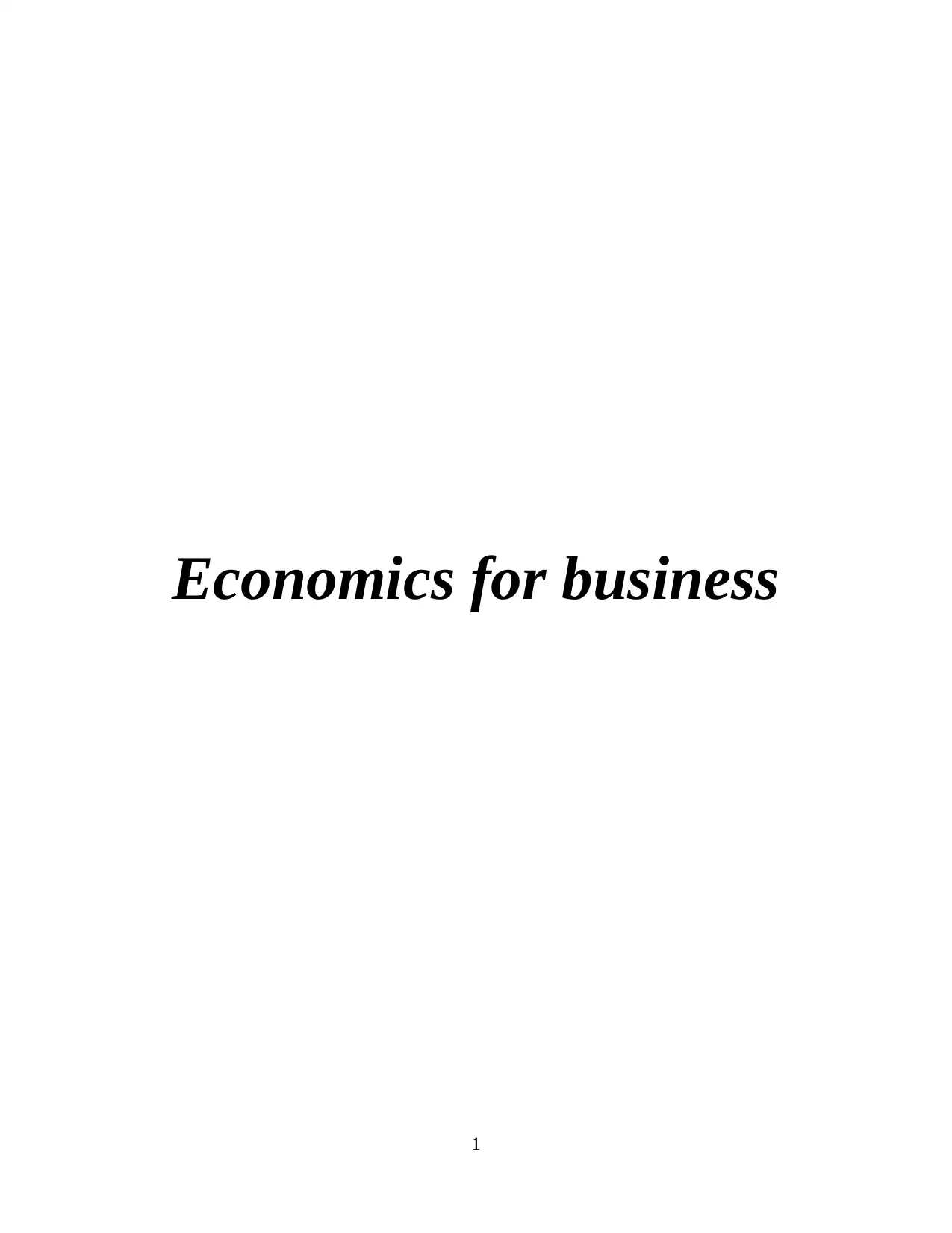
Economics for business
1
1
Paraphrase This Document
Need a fresh take? Get an instant paraphrase of this document with our AI Paraphraser
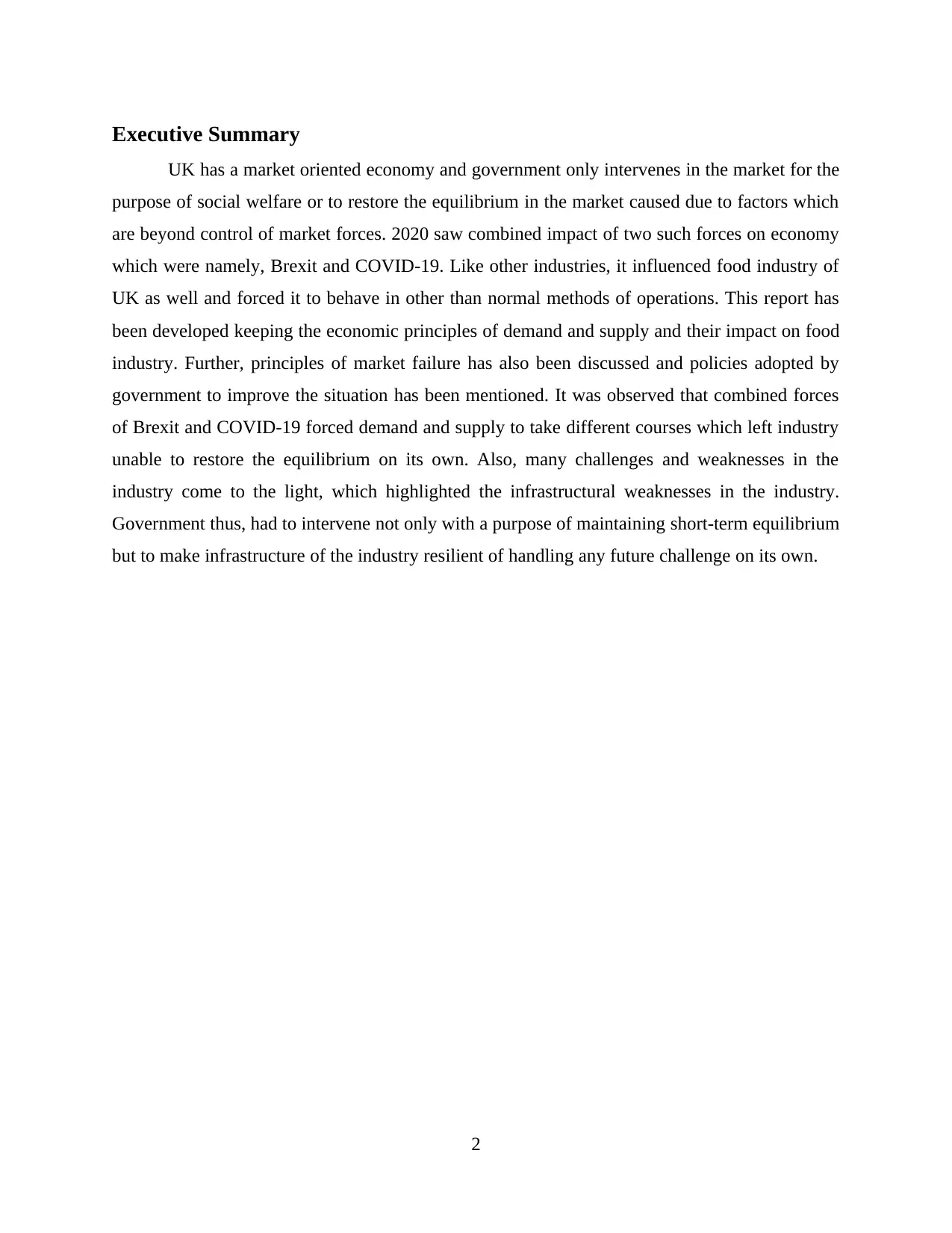
Executive Summary
UK has a market oriented economy and government only intervenes in the market for the
purpose of social welfare or to restore the equilibrium in the market caused due to factors which
are beyond control of market forces. 2020 saw combined impact of two such forces on economy
which were namely, Brexit and COVID-19. Like other industries, it influenced food industry of
UK as well and forced it to behave in other than normal methods of operations. This report has
been developed keeping the economic principles of demand and supply and their impact on food
industry. Further, principles of market failure has also been discussed and policies adopted by
government to improve the situation has been mentioned. It was observed that combined forces
of Brexit and COVID-19 forced demand and supply to take different courses which left industry
unable to restore the equilibrium on its own. Also, many challenges and weaknesses in the
industry come to the light, which highlighted the infrastructural weaknesses in the industry.
Government thus, had to intervene not only with a purpose of maintaining short-term equilibrium
but to make infrastructure of the industry resilient of handling any future challenge on its own.
2
UK has a market oriented economy and government only intervenes in the market for the
purpose of social welfare or to restore the equilibrium in the market caused due to factors which
are beyond control of market forces. 2020 saw combined impact of two such forces on economy
which were namely, Brexit and COVID-19. Like other industries, it influenced food industry of
UK as well and forced it to behave in other than normal methods of operations. This report has
been developed keeping the economic principles of demand and supply and their impact on food
industry. Further, principles of market failure has also been discussed and policies adopted by
government to improve the situation has been mentioned. It was observed that combined forces
of Brexit and COVID-19 forced demand and supply to take different courses which left industry
unable to restore the equilibrium on its own. Also, many challenges and weaknesses in the
industry come to the light, which highlighted the infrastructural weaknesses in the industry.
Government thus, had to intervene not only with a purpose of maintaining short-term equilibrium
but to make infrastructure of the industry resilient of handling any future challenge on its own.
2
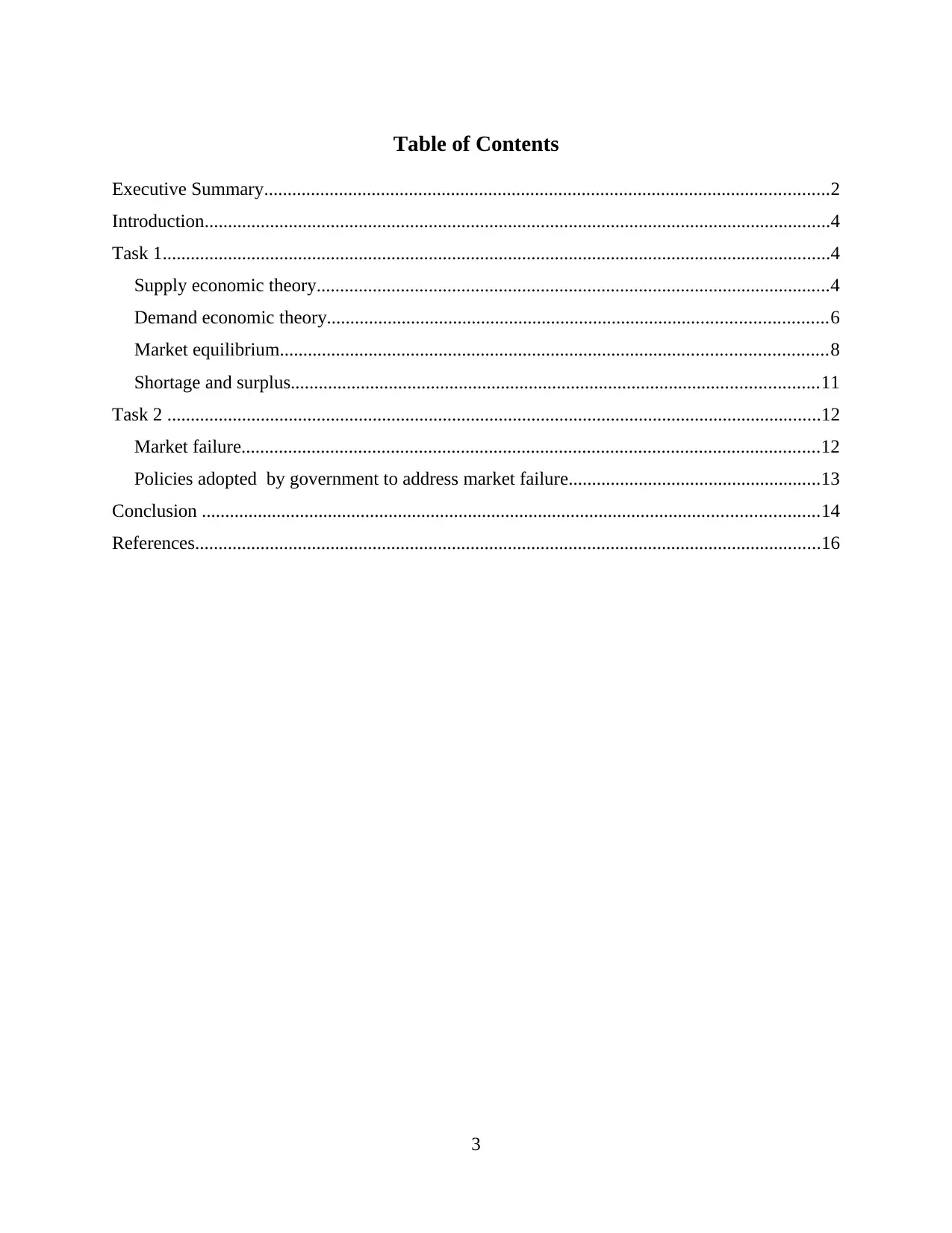
Table of Contents
Executive Summary.........................................................................................................................2
Introduction......................................................................................................................................4
Task 1...............................................................................................................................................4
Supply economic theory..............................................................................................................4
Demand economic theory...........................................................................................................6
Market equilibrium.....................................................................................................................8
Shortage and surplus.................................................................................................................11
Task 2 ............................................................................................................................................12
Market failure............................................................................................................................12
Policies adopted by government to address market failure......................................................13
Conclusion ....................................................................................................................................14
References......................................................................................................................................16
3
Executive Summary.........................................................................................................................2
Introduction......................................................................................................................................4
Task 1...............................................................................................................................................4
Supply economic theory..............................................................................................................4
Demand economic theory...........................................................................................................6
Market equilibrium.....................................................................................................................8
Shortage and surplus.................................................................................................................11
Task 2 ............................................................................................................................................12
Market failure............................................................................................................................12
Policies adopted by government to address market failure......................................................13
Conclusion ....................................................................................................................................14
References......................................................................................................................................16
3
⊘ This is a preview!⊘
Do you want full access?
Subscribe today to unlock all pages.

Trusted by 1+ million students worldwide
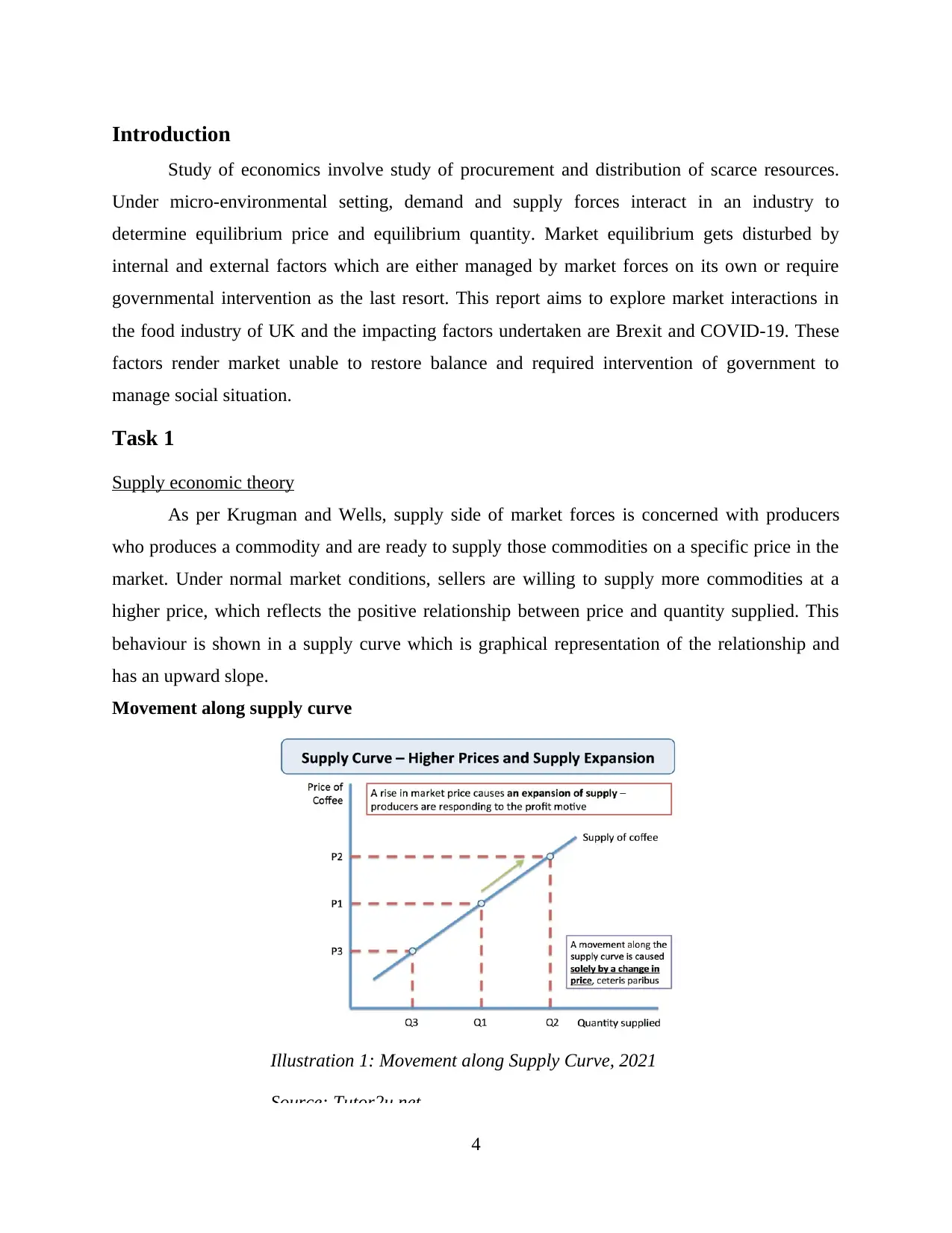
Introduction
Study of economics involve study of procurement and distribution of scarce resources.
Under micro-environmental setting, demand and supply forces interact in an industry to
determine equilibrium price and equilibrium quantity. Market equilibrium gets disturbed by
internal and external factors which are either managed by market forces on its own or require
governmental intervention as the last resort. This report aims to explore market interactions in
the food industry of UK and the impacting factors undertaken are Brexit and COVID-19. These
factors render market unable to restore balance and required intervention of government to
manage social situation.
Task 1
Supply economic theory
As per Krugman and Wells, supply side of market forces is concerned with producers
who produces a commodity and are ready to supply those commodities on a specific price in the
market. Under normal market conditions, sellers are willing to supply more commodities at a
higher price, which reflects the positive relationship between price and quantity supplied. This
behaviour is shown in a supply curve which is graphical representation of the relationship and
has an upward slope.
Movement along supply curve
Illustration 1: Movement along Supply Curve, 2021
Source: Tutor2u.net
4
Study of economics involve study of procurement and distribution of scarce resources.
Under micro-environmental setting, demand and supply forces interact in an industry to
determine equilibrium price and equilibrium quantity. Market equilibrium gets disturbed by
internal and external factors which are either managed by market forces on its own or require
governmental intervention as the last resort. This report aims to explore market interactions in
the food industry of UK and the impacting factors undertaken are Brexit and COVID-19. These
factors render market unable to restore balance and required intervention of government to
manage social situation.
Task 1
Supply economic theory
As per Krugman and Wells, supply side of market forces is concerned with producers
who produces a commodity and are ready to supply those commodities on a specific price in the
market. Under normal market conditions, sellers are willing to supply more commodities at a
higher price, which reflects the positive relationship between price and quantity supplied. This
behaviour is shown in a supply curve which is graphical representation of the relationship and
has an upward slope.
Movement along supply curve
Illustration 1: Movement along Supply Curve, 2021
Source: Tutor2u.net
4
Paraphrase This Document
Need a fresh take? Get an instant paraphrase of this document with our AI Paraphraser
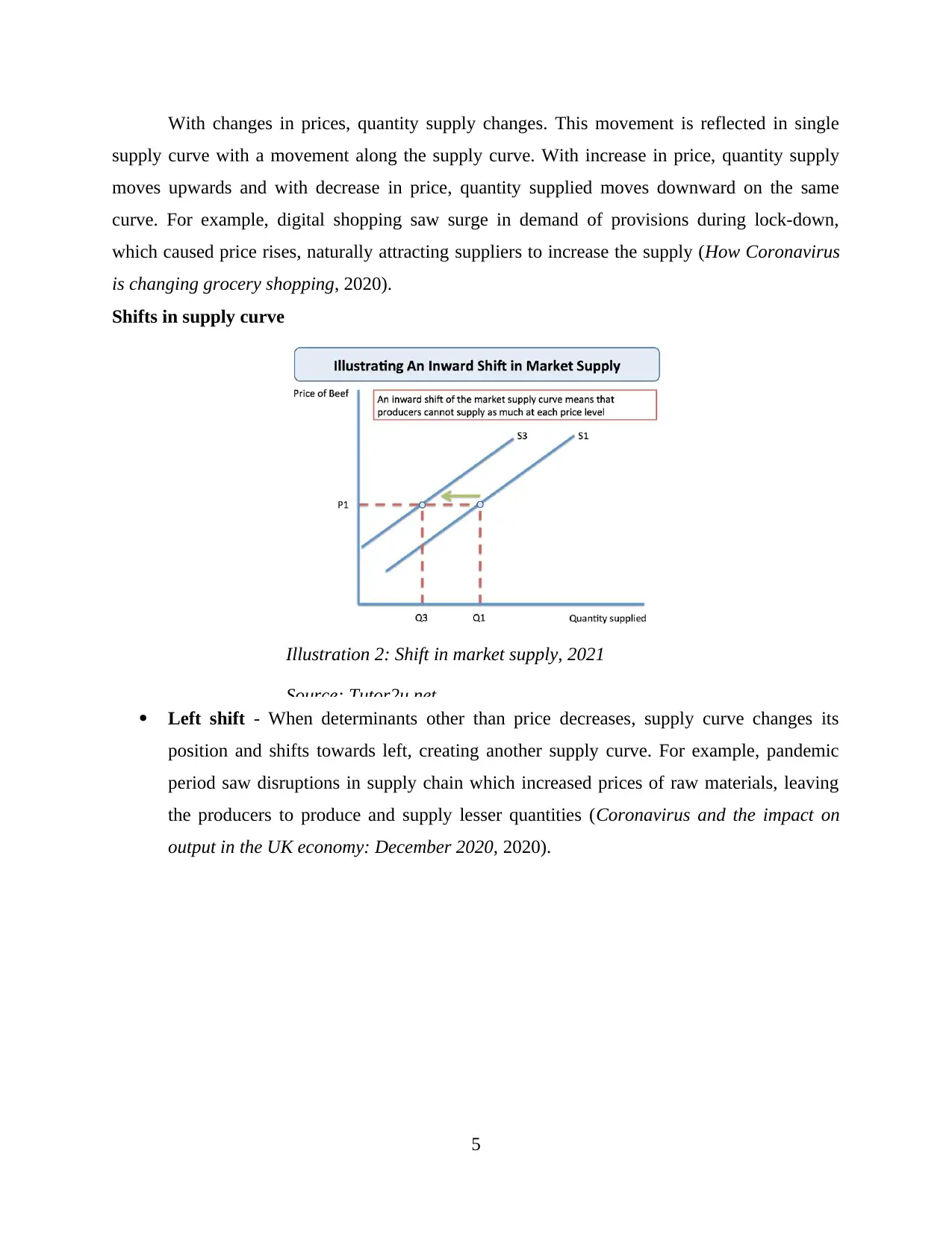
With changes in prices, quantity supply changes. This movement is reflected in single
supply curve with a movement along the supply curve. With increase in price, quantity supply
moves upwards and with decrease in price, quantity supplied moves downward on the same
curve. For example, digital shopping saw surge in demand of provisions during lock-down,
which caused price rises, naturally attracting suppliers to increase the supply (How Coronavirus
is changing grocery shopping, 2020).
Shifts in supply curve
Illustration 2: Shift in market supply, 2021
Source: Tutor2u.net
Left shift - When determinants other than price decreases, supply curve changes its
position and shifts towards left, creating another supply curve. For example, pandemic
period saw disruptions in supply chain which increased prices of raw materials, leaving
the producers to produce and supply lesser quantities (Coronavirus and the impact on
output in the UK economy: December 2020, 2020).
5
supply curve with a movement along the supply curve. With increase in price, quantity supply
moves upwards and with decrease in price, quantity supplied moves downward on the same
curve. For example, digital shopping saw surge in demand of provisions during lock-down,
which caused price rises, naturally attracting suppliers to increase the supply (How Coronavirus
is changing grocery shopping, 2020).
Shifts in supply curve
Illustration 2: Shift in market supply, 2021
Source: Tutor2u.net
Left shift - When determinants other than price decreases, supply curve changes its
position and shifts towards left, creating another supply curve. For example, pandemic
period saw disruptions in supply chain which increased prices of raw materials, leaving
the producers to produce and supply lesser quantities (Coronavirus and the impact on
output in the UK economy: December 2020, 2020).
5
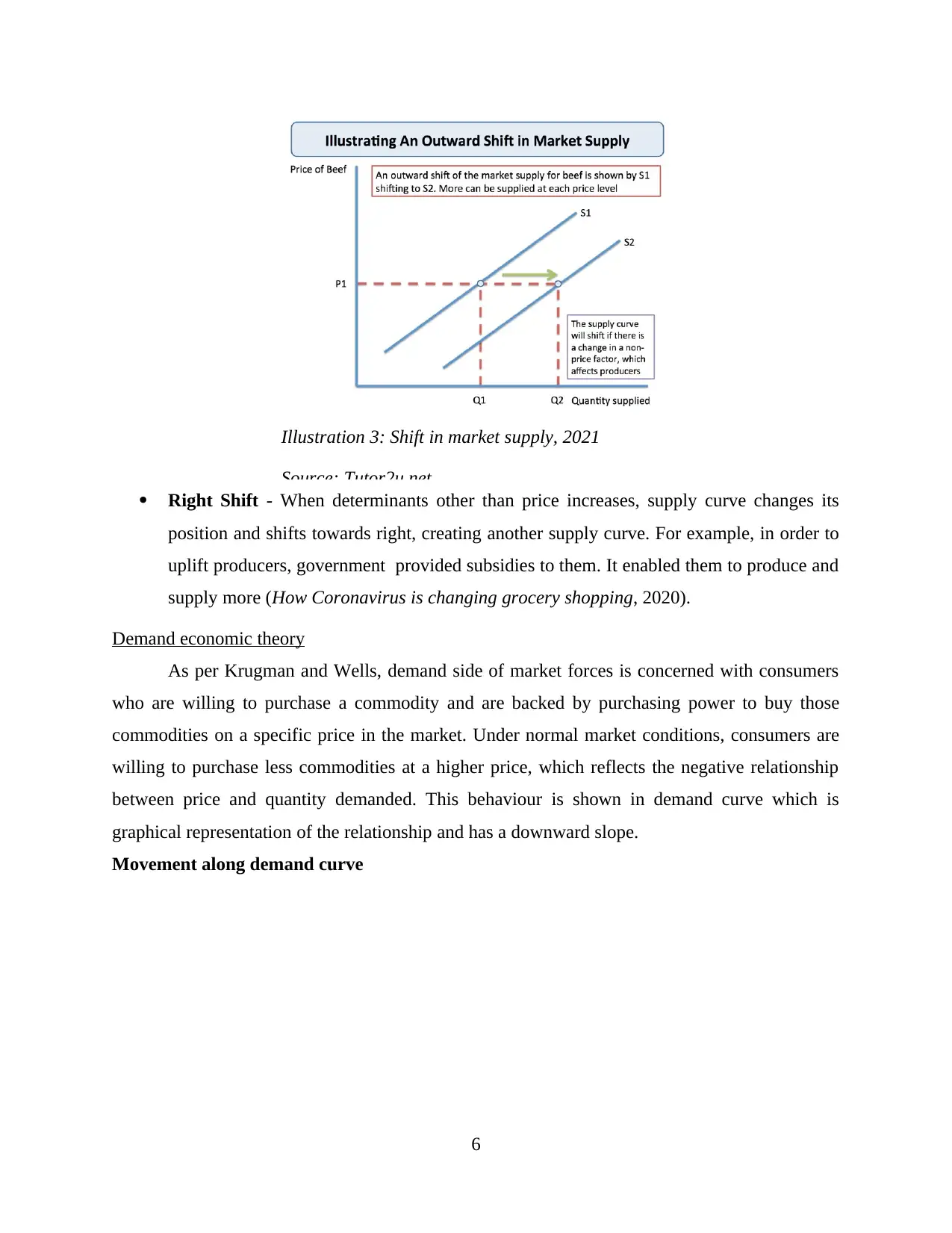
Illustration 3: Shift in market supply, 2021
Source: Tutor2u.net
Right Shift - When determinants other than price increases, supply curve changes its
position and shifts towards right, creating another supply curve. For example, in order to
uplift producers, government provided subsidies to them. It enabled them to produce and
supply more (How Coronavirus is changing grocery shopping, 2020).
Demand economic theory
As per Krugman and Wells, demand side of market forces is concerned with consumers
who are willing to purchase a commodity and are backed by purchasing power to buy those
commodities on a specific price in the market. Under normal market conditions, consumers are
willing to purchase less commodities at a higher price, which reflects the negative relationship
between price and quantity demanded. This behaviour is shown in demand curve which is
graphical representation of the relationship and has a downward slope.
Movement along demand curve
6
Source: Tutor2u.net
Right Shift - When determinants other than price increases, supply curve changes its
position and shifts towards right, creating another supply curve. For example, in order to
uplift producers, government provided subsidies to them. It enabled them to produce and
supply more (How Coronavirus is changing grocery shopping, 2020).
Demand economic theory
As per Krugman and Wells, demand side of market forces is concerned with consumers
who are willing to purchase a commodity and are backed by purchasing power to buy those
commodities on a specific price in the market. Under normal market conditions, consumers are
willing to purchase less commodities at a higher price, which reflects the negative relationship
between price and quantity demanded. This behaviour is shown in demand curve which is
graphical representation of the relationship and has a downward slope.
Movement along demand curve
6
⊘ This is a preview!⊘
Do you want full access?
Subscribe today to unlock all pages.

Trusted by 1+ million students worldwide
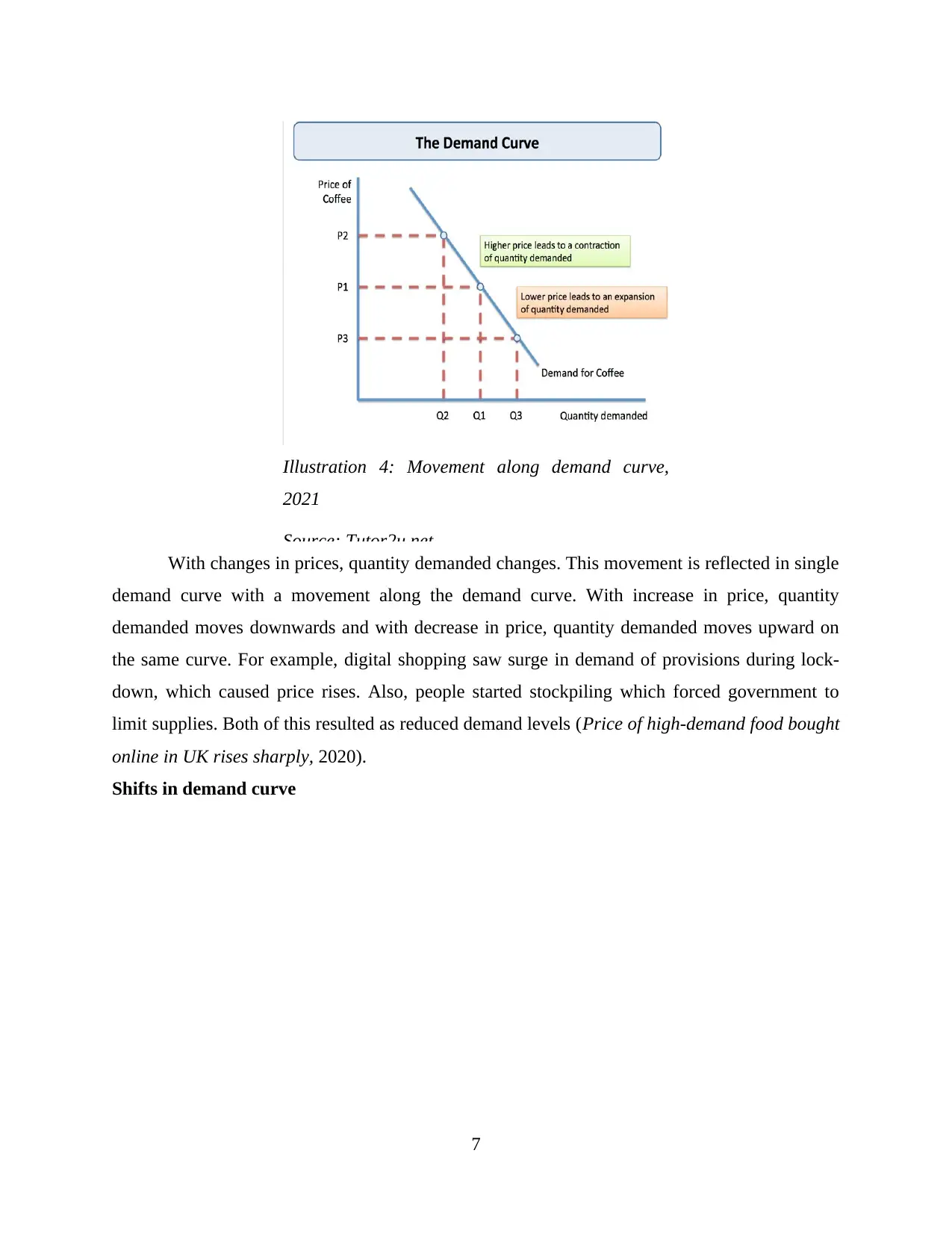
Illustration 4: Movement along demand curve,
2021
Source: Tutor2u.net
With changes in prices, quantity demanded changes. This movement is reflected in single
demand curve with a movement along the demand curve. With increase in price, quantity
demanded moves downwards and with decrease in price, quantity demanded moves upward on
the same curve. For example, digital shopping saw surge in demand of provisions during lock-
down, which caused price rises. Also, people started stockpiling which forced government to
limit supplies. Both of this resulted as reduced demand levels (Price of high-demand food bought
online in UK rises sharply, 2020).
Shifts in demand curve
7
2021
Source: Tutor2u.net
With changes in prices, quantity demanded changes. This movement is reflected in single
demand curve with a movement along the demand curve. With increase in price, quantity
demanded moves downwards and with decrease in price, quantity demanded moves upward on
the same curve. For example, digital shopping saw surge in demand of provisions during lock-
down, which caused price rises. Also, people started stockpiling which forced government to
limit supplies. Both of this resulted as reduced demand levels (Price of high-demand food bought
online in UK rises sharply, 2020).
Shifts in demand curve
7
Paraphrase This Document
Need a fresh take? Get an instant paraphrase of this document with our AI Paraphraser
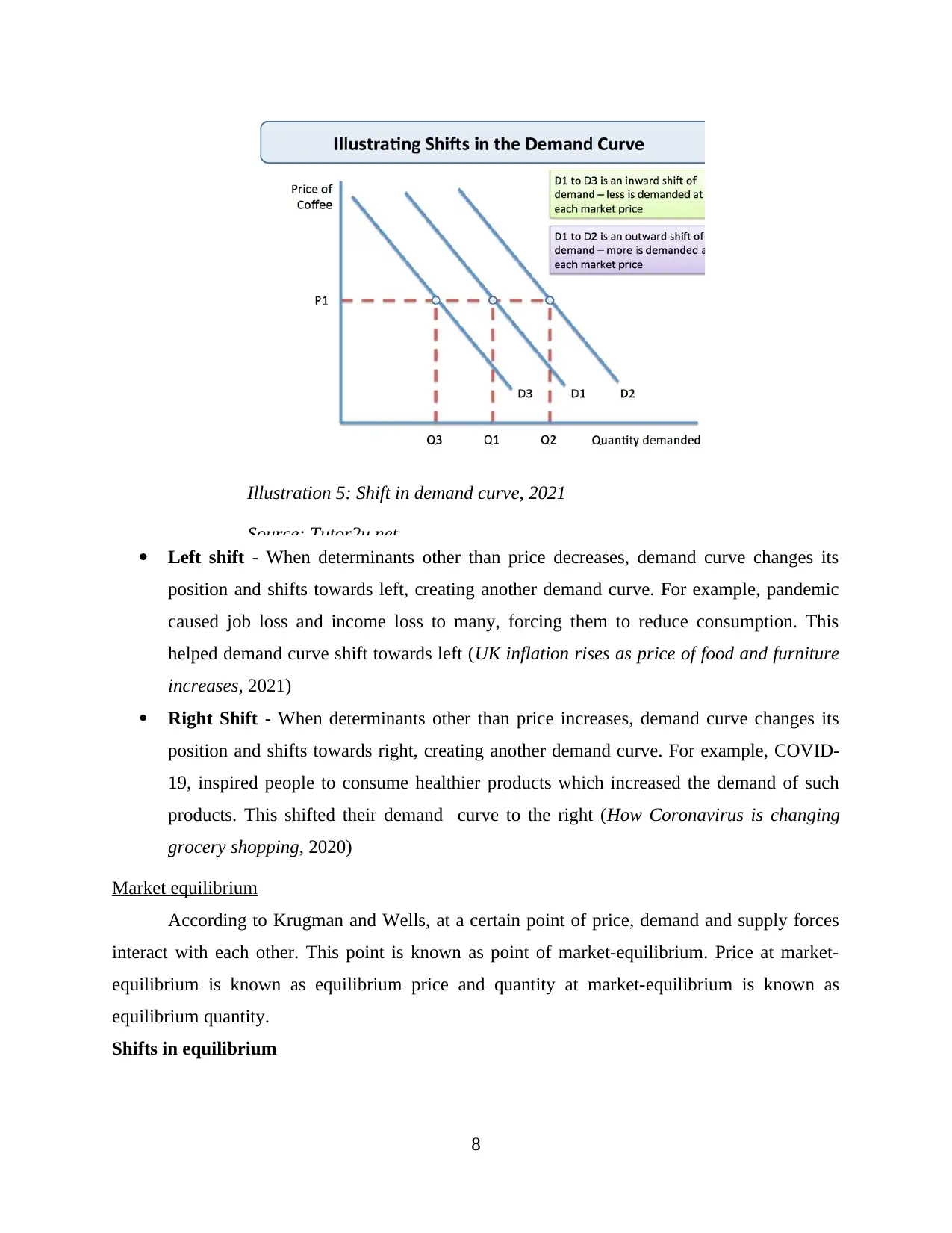
Illustration 5: Shift in demand curve, 2021
Source: Tutor2u.net
Left shift - When determinants other than price decreases, demand curve changes its
position and shifts towards left, creating another demand curve. For example, pandemic
caused job loss and income loss to many, forcing them to reduce consumption. This
helped demand curve shift towards left (UK inflation rises as price of food and furniture
increases, 2021)
Right Shift - When determinants other than price increases, demand curve changes its
position and shifts towards right, creating another demand curve. For example, COVID-
19, inspired people to consume healthier products which increased the demand of such
products. This shifted their demand curve to the right (How Coronavirus is changing
grocery shopping, 2020)
Market equilibrium
According to Krugman and Wells, at a certain point of price, demand and supply forces
interact with each other. This point is known as point of market-equilibrium. Price at market-
equilibrium is known as equilibrium price and quantity at market-equilibrium is known as
equilibrium quantity.
Shifts in equilibrium
8
Source: Tutor2u.net
Left shift - When determinants other than price decreases, demand curve changes its
position and shifts towards left, creating another demand curve. For example, pandemic
caused job loss and income loss to many, forcing them to reduce consumption. This
helped demand curve shift towards left (UK inflation rises as price of food and furniture
increases, 2021)
Right Shift - When determinants other than price increases, demand curve changes its
position and shifts towards right, creating another demand curve. For example, COVID-
19, inspired people to consume healthier products which increased the demand of such
products. This shifted their demand curve to the right (How Coronavirus is changing
grocery shopping, 2020)
Market equilibrium
According to Krugman and Wells, at a certain point of price, demand and supply forces
interact with each other. This point is known as point of market-equilibrium. Price at market-
equilibrium is known as equilibrium price and quantity at market-equilibrium is known as
equilibrium quantity.
Shifts in equilibrium
8
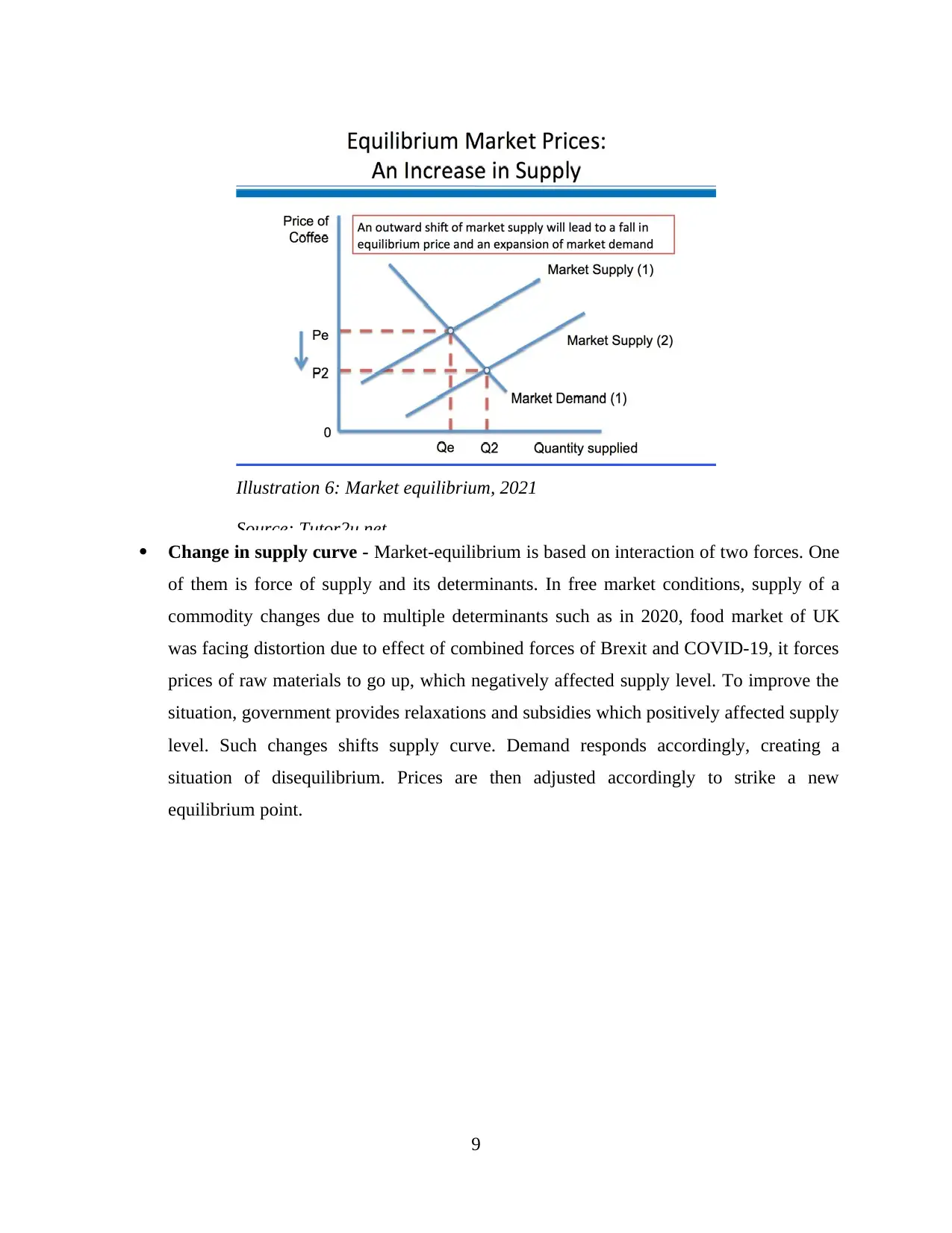
Illustration 6: Market equilibrium, 2021
Source: Tutor2u.net
Change in supply curve - Market-equilibrium is based on interaction of two forces. One
of them is force of supply and its determinants. In free market conditions, supply of a
commodity changes due to multiple determinants such as in 2020, food market of UK
was facing distortion due to effect of combined forces of Brexit and COVID-19, it forces
prices of raw materials to go up, which negatively affected supply level. To improve the
situation, government provides relaxations and subsidies which positively affected supply
level. Such changes shifts supply curve. Demand responds accordingly, creating a
situation of disequilibrium. Prices are then adjusted accordingly to strike a new
equilibrium point.
9
Source: Tutor2u.net
Change in supply curve - Market-equilibrium is based on interaction of two forces. One
of them is force of supply and its determinants. In free market conditions, supply of a
commodity changes due to multiple determinants such as in 2020, food market of UK
was facing distortion due to effect of combined forces of Brexit and COVID-19, it forces
prices of raw materials to go up, which negatively affected supply level. To improve the
situation, government provides relaxations and subsidies which positively affected supply
level. Such changes shifts supply curve. Demand responds accordingly, creating a
situation of disequilibrium. Prices are then adjusted accordingly to strike a new
equilibrium point.
9
⊘ This is a preview!⊘
Do you want full access?
Subscribe today to unlock all pages.

Trusted by 1+ million students worldwide
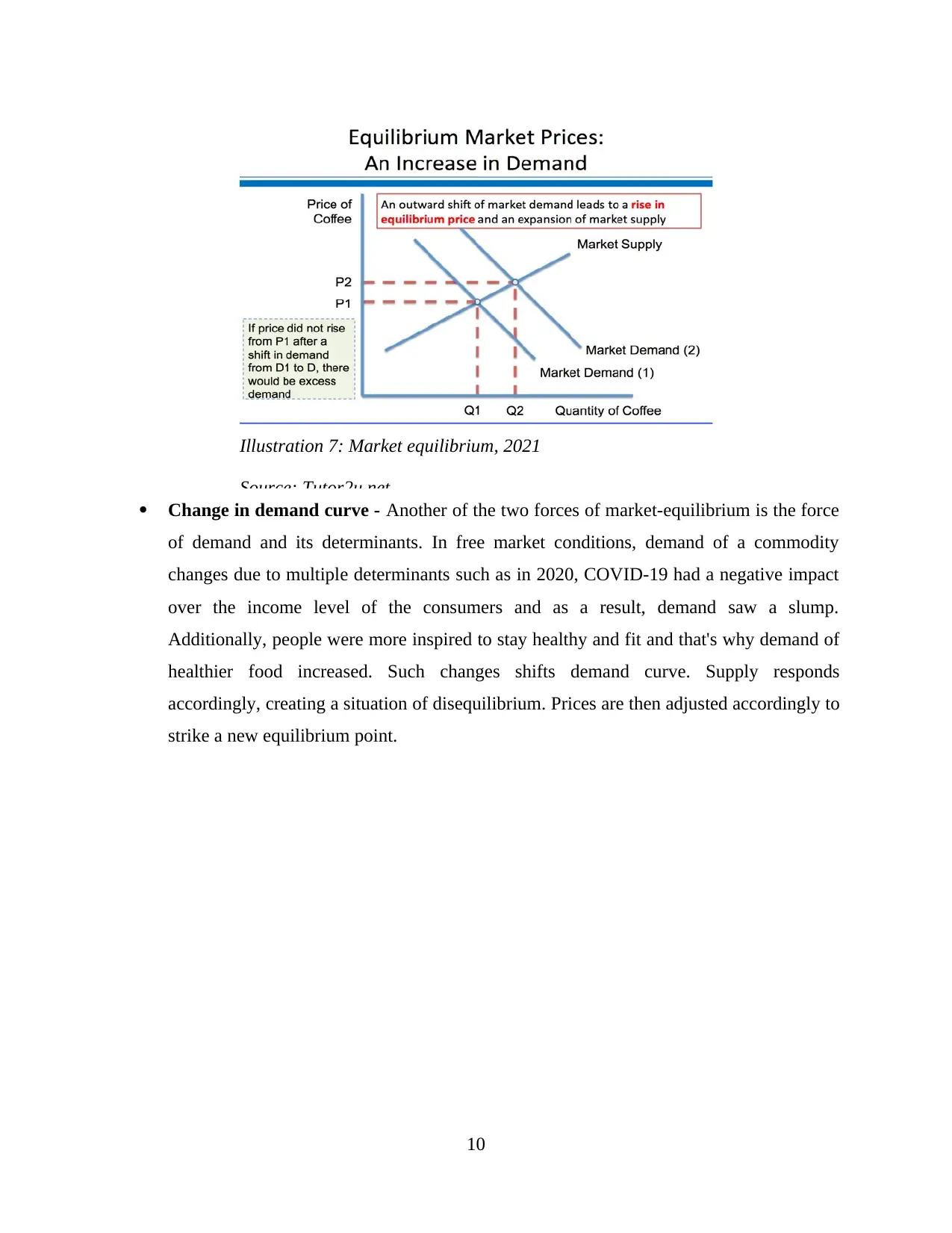
Illustration 7: Market equilibrium, 2021
Source: Tutor2u.net
Change in demand curve - Another of the two forces of market-equilibrium is the force
of demand and its determinants. In free market conditions, demand of a commodity
changes due to multiple determinants such as in 2020, COVID-19 had a negative impact
over the income level of the consumers and as a result, demand saw a slump.
Additionally, people were more inspired to stay healthy and fit and that's why demand of
healthier food increased. Such changes shifts demand curve. Supply responds
accordingly, creating a situation of disequilibrium. Prices are then adjusted accordingly to
strike a new equilibrium point.
10
Source: Tutor2u.net
Change in demand curve - Another of the two forces of market-equilibrium is the force
of demand and its determinants. In free market conditions, demand of a commodity
changes due to multiple determinants such as in 2020, COVID-19 had a negative impact
over the income level of the consumers and as a result, demand saw a slump.
Additionally, people were more inspired to stay healthy and fit and that's why demand of
healthier food increased. Such changes shifts demand curve. Supply responds
accordingly, creating a situation of disequilibrium. Prices are then adjusted accordingly to
strike a new equilibrium point.
10
Paraphrase This Document
Need a fresh take? Get an instant paraphrase of this document with our AI Paraphraser
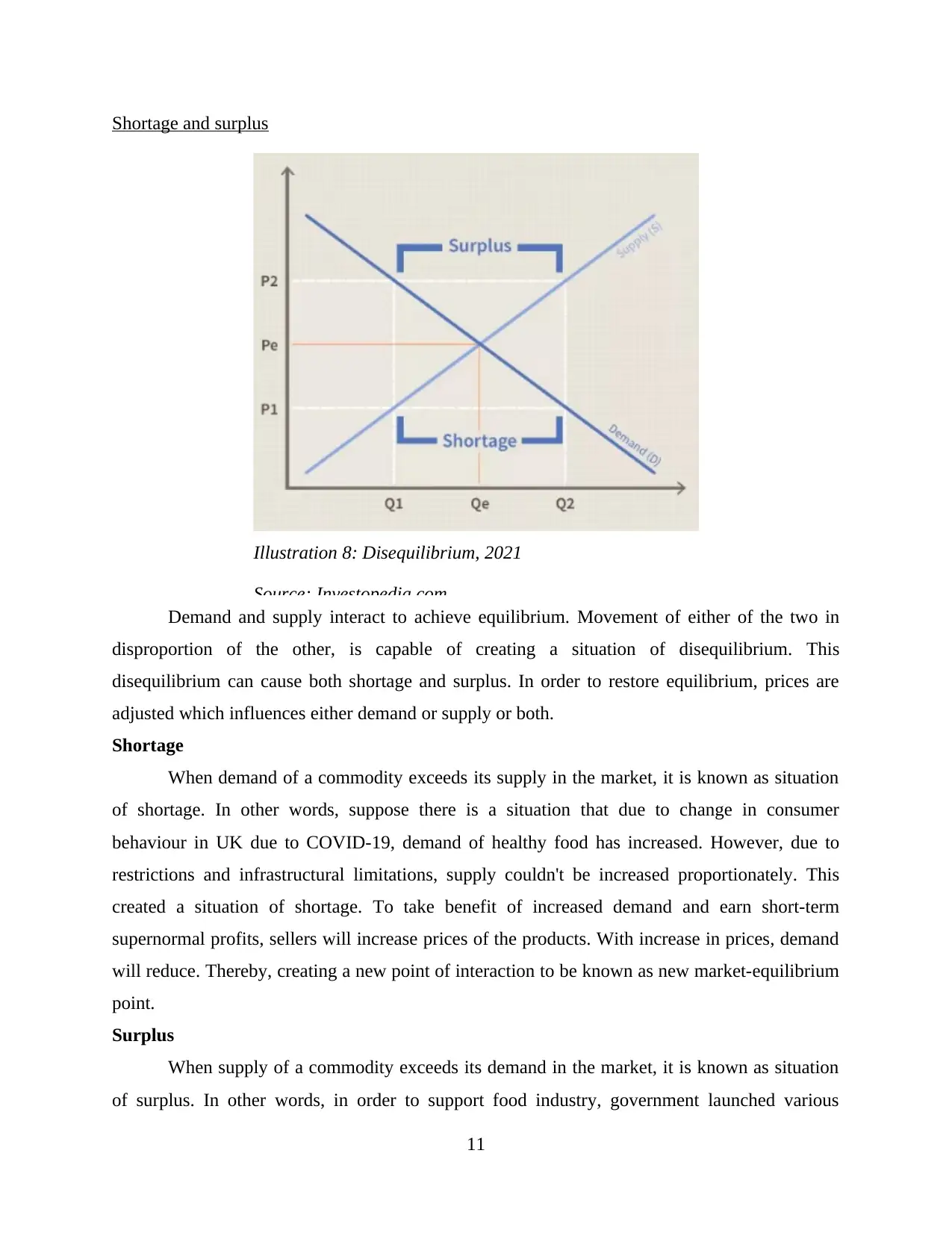
Shortage and surplus
Illustration 8: Disequilibrium, 2021
Source: Investopedia.com
Demand and supply interact to achieve equilibrium. Movement of either of the two in
disproportion of the other, is capable of creating a situation of disequilibrium. This
disequilibrium can cause both shortage and surplus. In order to restore equilibrium, prices are
adjusted which influences either demand or supply or both.
Shortage
When demand of a commodity exceeds its supply in the market, it is known as situation
of shortage. In other words, suppose there is a situation that due to change in consumer
behaviour in UK due to COVID-19, demand of healthy food has increased. However, due to
restrictions and infrastructural limitations, supply couldn't be increased proportionately. This
created a situation of shortage. To take benefit of increased demand and earn short-term
supernormal profits, sellers will increase prices of the products. With increase in prices, demand
will reduce. Thereby, creating a new point of interaction to be known as new market-equilibrium
point.
Surplus
When supply of a commodity exceeds its demand in the market, it is known as situation
of surplus. In other words, in order to support food industry, government launched various
11
Illustration 8: Disequilibrium, 2021
Source: Investopedia.com
Demand and supply interact to achieve equilibrium. Movement of either of the two in
disproportion of the other, is capable of creating a situation of disequilibrium. This
disequilibrium can cause both shortage and surplus. In order to restore equilibrium, prices are
adjusted which influences either demand or supply or both.
Shortage
When demand of a commodity exceeds its supply in the market, it is known as situation
of shortage. In other words, suppose there is a situation that due to change in consumer
behaviour in UK due to COVID-19, demand of healthy food has increased. However, due to
restrictions and infrastructural limitations, supply couldn't be increased proportionately. This
created a situation of shortage. To take benefit of increased demand and earn short-term
supernormal profits, sellers will increase prices of the products. With increase in prices, demand
will reduce. Thereby, creating a new point of interaction to be known as new market-equilibrium
point.
Surplus
When supply of a commodity exceeds its demand in the market, it is known as situation
of surplus. In other words, in order to support food industry, government launched various
11
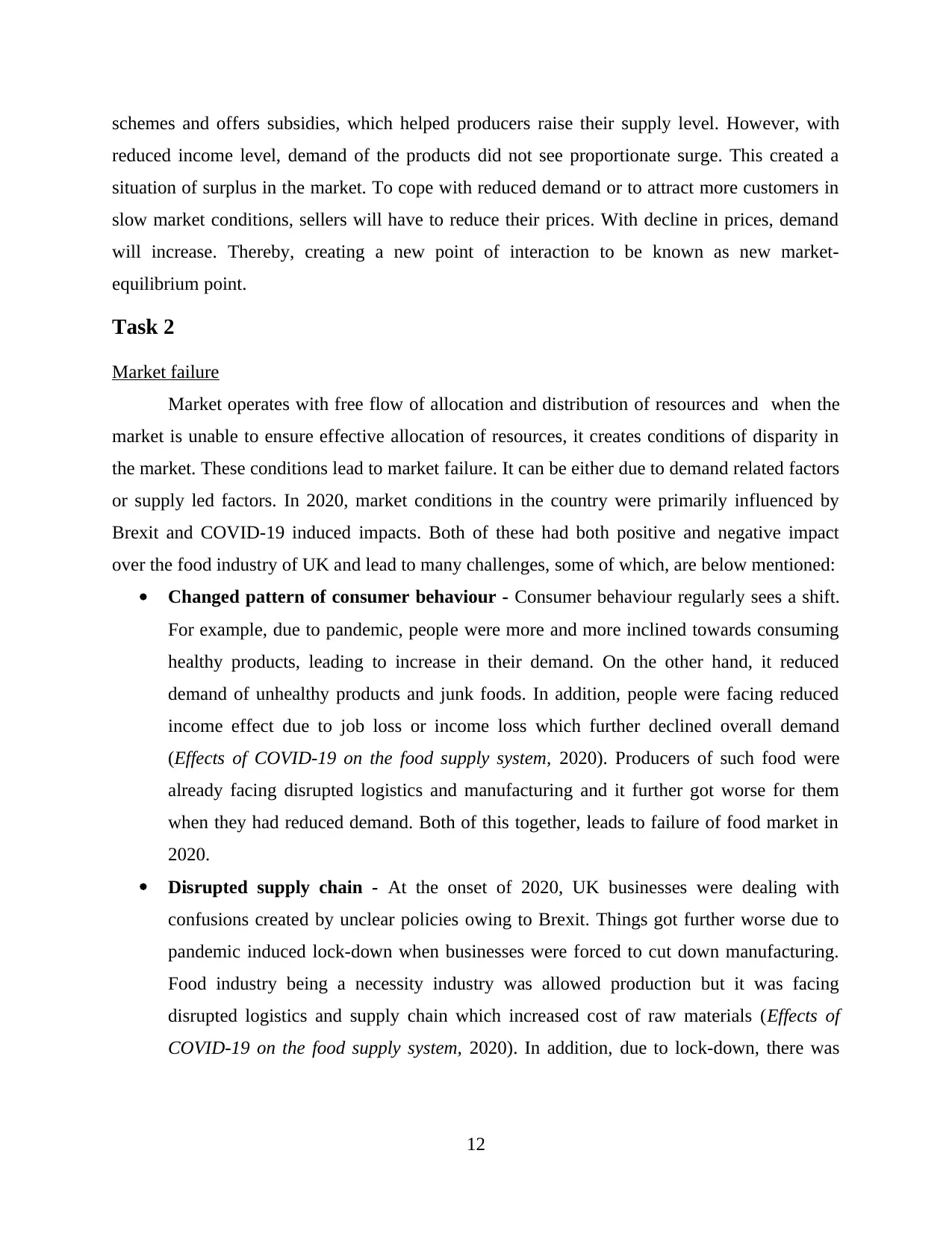
schemes and offers subsidies, which helped producers raise their supply level. However, with
reduced income level, demand of the products did not see proportionate surge. This created a
situation of surplus in the market. To cope with reduced demand or to attract more customers in
slow market conditions, sellers will have to reduce their prices. With decline in prices, demand
will increase. Thereby, creating a new point of interaction to be known as new market-
equilibrium point.
Task 2
Market failure
Market operates with free flow of allocation and distribution of resources and when the
market is unable to ensure effective allocation of resources, it creates conditions of disparity in
the market. These conditions lead to market failure. It can be either due to demand related factors
or supply led factors. In 2020, market conditions in the country were primarily influenced by
Brexit and COVID-19 induced impacts. Both of these had both positive and negative impact
over the food industry of UK and lead to many challenges, some of which, are below mentioned:
Changed pattern of consumer behaviour - Consumer behaviour regularly sees a shift.
For example, due to pandemic, people were more and more inclined towards consuming
healthy products, leading to increase in their demand. On the other hand, it reduced
demand of unhealthy products and junk foods. In addition, people were facing reduced
income effect due to job loss or income loss which further declined overall demand
(Effects of COVID-19 on the food supply system, 2020). Producers of such food were
already facing disrupted logistics and manufacturing and it further got worse for them
when they had reduced demand. Both of this together, leads to failure of food market in
2020.
Disrupted supply chain - At the onset of 2020, UK businesses were dealing with
confusions created by unclear policies owing to Brexit. Things got further worse due to
pandemic induced lock-down when businesses were forced to cut down manufacturing.
Food industry being a necessity industry was allowed production but it was facing
disrupted logistics and supply chain which increased cost of raw materials (Effects of
COVID-19 on the food supply system, 2020). In addition, due to lock-down, there was
12
reduced income level, demand of the products did not see proportionate surge. This created a
situation of surplus in the market. To cope with reduced demand or to attract more customers in
slow market conditions, sellers will have to reduce their prices. With decline in prices, demand
will increase. Thereby, creating a new point of interaction to be known as new market-
equilibrium point.
Task 2
Market failure
Market operates with free flow of allocation and distribution of resources and when the
market is unable to ensure effective allocation of resources, it creates conditions of disparity in
the market. These conditions lead to market failure. It can be either due to demand related factors
or supply led factors. In 2020, market conditions in the country were primarily influenced by
Brexit and COVID-19 induced impacts. Both of these had both positive and negative impact
over the food industry of UK and lead to many challenges, some of which, are below mentioned:
Changed pattern of consumer behaviour - Consumer behaviour regularly sees a shift.
For example, due to pandemic, people were more and more inclined towards consuming
healthy products, leading to increase in their demand. On the other hand, it reduced
demand of unhealthy products and junk foods. In addition, people were facing reduced
income effect due to job loss or income loss which further declined overall demand
(Effects of COVID-19 on the food supply system, 2020). Producers of such food were
already facing disrupted logistics and manufacturing and it further got worse for them
when they had reduced demand. Both of this together, leads to failure of food market in
2020.
Disrupted supply chain - At the onset of 2020, UK businesses were dealing with
confusions created by unclear policies owing to Brexit. Things got further worse due to
pandemic induced lock-down when businesses were forced to cut down manufacturing.
Food industry being a necessity industry was allowed production but it was facing
disrupted logistics and supply chain which increased cost of raw materials (Effects of
COVID-19 on the food supply system, 2020). In addition, due to lock-down, there was
12
⊘ This is a preview!⊘
Do you want full access?
Subscribe today to unlock all pages.

Trusted by 1+ million students worldwide
1 out of 16
Related Documents
Your All-in-One AI-Powered Toolkit for Academic Success.
+13062052269
info@desklib.com
Available 24*7 on WhatsApp / Email
![[object Object]](/_next/static/media/star-bottom.7253800d.svg)
Unlock your academic potential
Copyright © 2020–2025 A2Z Services. All Rights Reserved. Developed and managed by ZUCOL.





